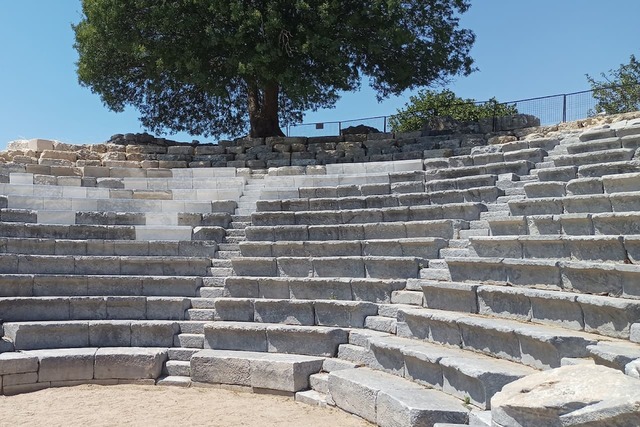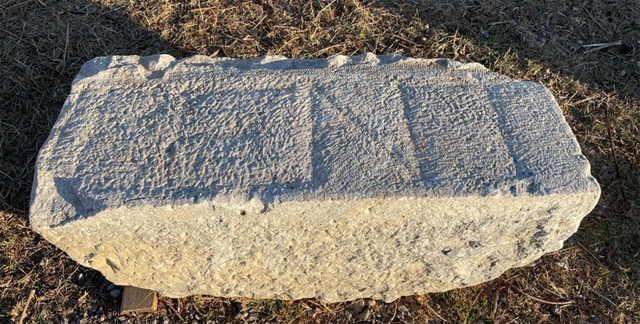Beneath the sun-drenched ruins of Teos, an ancient city on the western coast of Turkey, archaeologists are uncovering secrets that have been buried for centuries. Known for its rich cultural history and strategic location, Teos was once a vibrant hub of art and commerce. Recent discoveries, including intricate mosaics and monumental inscriptions, have begun to unravel the city’s hidden past, offering a fresh glimpse into its political and artistic legacy. As the layers of time are peeled back, the city’s role in the Hellenistic and Roman world becomes clearer, revealing the complex intertwining of art, politics, and religion.
Teos Archaeological Project: Excavating the Bouleuterion
Teos was an important city during both the Hellenistic and Roman periods, and its archaeological significance continues to be revealed through ongoing excavation work. Led by archaeologist Mantha Zarmakoupi, a professor at the University of Pennsylvania, the Teos Archaeological Project has focused much of its efforts on uncovering the bouleuterion, a central city council building. The bouleuterion was integral to the city’s political life, serving as the site of public deliberations and democratic governance.
Since 2018, Zarmakoupi and her team have been unearthing key elements of the building, offering a glimpse into the architectural evolution of Teos and its democratic institutions. The bouleuterion was originally constructed in the late 3rd century BCE during the Hellenistic period, but it underwent significant modifications under Roman rule. One of the most striking features of the excavation is the preservation of the bouleuterion’s architectural details, including sloping curvilinear stone seating that would have supported the council members during deliberations.

This building serves as the best-preserved structure in Teos, providing researchers with crucial insights into the civic and political life of the city. Moreover, the excavation team has managed to establish a precise timeline for the bouleuterion’s construction and modifications, making it a key site for understanding the city’s evolution from the Hellenistic to the Roman period.
Video
Watch the video Exploring Early Roman Mosaics to dive into the intricate art and craftsmanship of ancient Roman culture.
Unearthing the Past: The Discovery of the Mosaics
Amid the layers of built-up dirt and debris, archaeologists at Teos made an extraordinary discovery—mosaics that had lain hidden for centuries. These mosaics, which date back to the 3rd century BCE, were found in separate rooms of the bouleuterion and have since captured the attention of scholars and art historians alike.

One of the mosaics features two cupids in combat, a depiction that is both rare and significant. In ancient Greek and Roman art, cupids were often associated with the god Eros, the personification of love. This particular mosaic stands out for its dramatic portrayal of these playful yet combative figures, offering a unique interpretation of Eros and his relationship with other deities.
The discovery of this mosaic is remarkable not only for its artistic value but also for its cultural significance. The figures of cupids are closely linked to Dionysus, the Greek god of wine, revelry, and fertility—deities who held a special place in the hearts of the people of Teos. This connection reinforces the city’s reputation as a center of Bacchic worship and highlights the central role that Dionysian themes played in the city’s cultural life. The inclusion of such symbols in the mosaic underscores the interwoven nature of art, religion, and politics in ancient Teos.
Iconography of the Mosaics: Symbolism of Eros and Dionysus
The figures depicted in the mosaics—two cupids engaged in combat—offer fascinating insights into the symbolic use of art in ancient Teos. Eros, the god of love, was often depicted as a mischievous figure who could both inspire passion and cause chaos. The idea of two cupids fighting is a playful and ironic twist on the typical depiction of love as a harmonious force. This portrayal aligns with the Dionysian themes of Teos, where chaos and celebration were often seen as integral aspects of life and worship.
The god Dionysus, to whom Teos was devoted, was often linked to themes of intoxication, fertility, and ecstasy. The cupids’ combat may have symbolized the struggle between love and the more chaotic forces that Dionysus embodied. This artwork captures the duality of human experience, where love and conflict, harmony and chaos, are constantly at odds. By incorporating these figures into the city’s most important political building, the bouleuterion, the artists may have been reflecting the complex and often tumultuous nature of political life in Teos itself.
The Monumental Inscription: Decoding Ancient Political Messages
In addition to the discovery of the mosaics, another important find at the site was a monumental inscription that had been partially erased. This inscription, originally located on the architrave blocks that once sat atop the columns of the bouleuterion, provides critical insight into the political structure of Teos.

The inscription, once fully deciphered, is expected to reveal more about the governance of Teos and the individuals involved in its political processes. While much of the text has been obscured, it is believed to contain references to key political figures and decisions made in the bouleuterion. The inscription also offers clues about the city’s political philosophy and its role within the broader Hellenistic world.
The monumental inscription adds an important layer to our understanding of Teos as a democratic city. Its discovery underscores the importance of written records in the functioning of ancient societies and provides a tangible link between the city’s artistic and political life. The continued analysis of this inscription will likely yield further revelations about Teos’ democratic structures and the people who shaped its history.
Architectural Evolution of the Bouleuterion
The bouleuterion of Teos is not just an architectural marvel; it is also a testament to the city’s political evolution. Initially built during the late 3rd century BCE, the bouleuterion was a center for democratic deliberation. Its architectural design, with its sloping stone seating and large public space, reflected the city’s commitment to open debate and civic participation.
In the 1st century AD, during Roman rule, the bouleuterion underwent significant changes, including the addition of a portico. These modifications illustrate the impact of Roman influence on Teos, as the city adapted to the political realities of the time while retaining its Hellenistic roots. The bouleuterion thus serves as a symbol of Teos’ ability to evolve while maintaining its core democratic principles.
Video
Watch the video The 2,000-Year-Old City of Mosaics to uncover the fascinating history and stunning art of this ancient city.
Conclusion: Unveiling Teos’ Hidden Legacy
The discoveries at Teos—particularly the mosaics depicting cupids in combat and the monumental inscription—have provided invaluable insights into the city’s artistic, political, and cultural life. Through the work of archaeologists like Mantha Zarmakoupi and her team, Teos continues to unveil its hidden legacy, offering a rare glimpse into the Hellenistic and Roman worlds.
These findings not only enrich our understanding of ancient Mediterranean civilizations but also remind us of the interconnectedness of art, religion, and politics in shaping the history of ancient cities. As excavations at Teos continue, we can expect even more revelations that will further illuminate the significance of this once-great city and its enduring influence on the history of democracy and art.



